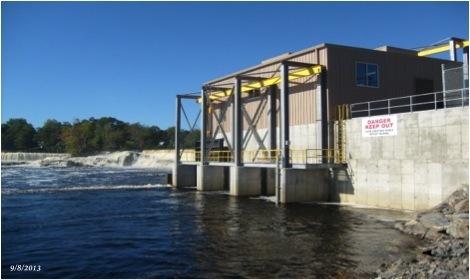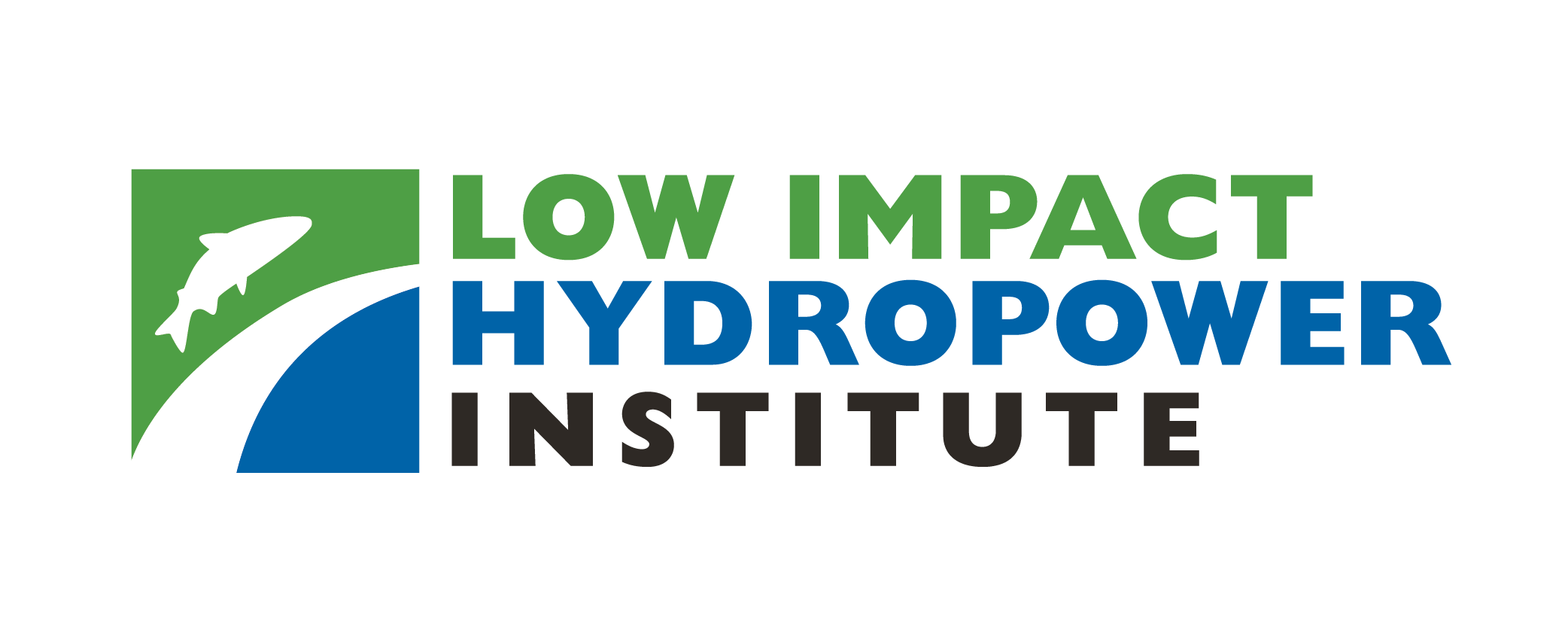LIHI 证书 #67 - 缅因州斯蒂尔沃特项目

| 项目名称 | 死水 |
| LIHI 证书编号 | 67 |
| LIHI 证书期限 | 2020 年 6 月 1 日 – 2030 年 5 月 31 日(可选择延长至 2033 年 5 月 31 日) |
| 所有者 | Black Bear Hydro Partners, LLC,布鲁克菲尔德可再生能源集团的子公司 |
| 状态 | 缅因州 |
| 地点 | 位于缅因州老城区佩诺布斯科特河斯蒂尔沃特支流 2.4 英里处。 |
| 装机容量 | 总计:4.179 兆瓦
发电站 答:1.929 兆瓦 发电站B:2.25兆瓦 |
| 平均年发电量 | 总计:21,153 兆瓦时
发电厂A:9,764 MWh B电站:11,389 MWh |
| 设施类型 | 径流式 |
| 联邦能源管理委员会 不。 | P-2712 于 1998 年签发,有效期至 2048 年 3 月 31 日 |
斯蒂尔沃特项目位于缅因州佩诺布斯科特县斯蒂尔沃特镇的佩诺布斯科特河斯蒂尔沃特支流。该项目位于老城区附近,原为伐木和磨坊场地。该场地于1902年由奥罗诺纸浆造纸公司开发成一座正在运营的水力发电设施。 发电站 (现为 A 号发电站)建在 坝 1932年,原有的发电站被废弃,到1942年,大坝东南段仍可见其遗迹。B型发电站于2013年建成。新的下游 鱼道 设施和 鳗梯 分别于2014年和2016年开始运营。
佩诺布斯科特河流域是新英格兰第二大河流系统,流域面积达8570平方英里。该流域包括佩诺布斯科特河的东支和西支、皮斯卡塔奎斯河、塞贝克河、普莱森特河、马塔瓦姆基格河、帕萨杜姆基格河、斯蒂尔沃特支以及佩诺布斯科特河的主干。该项目位于 奥罗诺项目 (LIHI #66) 吉尔曼瀑布下游几英里处 坝 (部分 米尔福德项目,LIHI #113)。随着2013年11月维齐大坝的拆除,奥罗诺项目下游的佩诺布斯科特河上不再有任何水坝。奥罗诺项目泄洪口位于斯蒂尔沃特支流与佩诺布斯科特河主干流交汇处上游约800英尺处。拆除维齐大坝和大工程大坝是全国公认的佩诺布斯科特河修复工程的一项重要内容。
斯蒂尔沃特项目是佩诺布斯科特河修复协议的组成部分。该协议的总体目标是改善佩诺布斯科特河的环境资源,降低并尽量减少业主水电项目对这些资源的影响,同时保持河流的可再生水力发电水平。这项修复工程是美国历史上规模最大的河流修复项目之一。在前所未有的合作中,来自不同利益相关方的通力合作,在维持能源生产的同时,将11种海鱼恢复到佩诺布斯科特河。
Stillwater 项目由一个主要混凝土 重力坝,长约1,720英尺,由13段不同高度的河段组成。A发电厂包含四台水轮发电机组,总装机容量为1.929兆瓦。B发电厂包含三台水轮发电机组,总装机容量为2.25兆瓦。斯蒂尔沃特项目在B发电厂0.6英里长的绕行河段西侧水道内设有一条上游鳗鱼通道。
该项目采用 径流 该项目采用蓄水模式,并蓄水191英亩的水库。该项目为东水道提供最低70立方英尺/秒的流量,为西水道提供1-2立方英尺/秒的流量。这些流量促进了洄游和留鸟物种的绕行栖息地,并增强了鳗鱼的上游通道。该流量方案是作为和解协议的一部分,在缅因州环境保护部和佩诺布斯科特印第安部落等相关方的协商下制定的。
项目河段水域被指定为B级,适合鱼类繁殖和生存,以及主要的休闲娱乐活动。佩诺布斯科特河的斯蒂尔沃特支流未被列入任何损害名单。项目业主在B电站建设后进行了水质监测,结果表明项目运营并未对河段水质产生不利影响。
海洄游动物 佩诺布斯科特河中现存的物种包括西鲱、大西洋鲑鱼、美洲西鲱、七鳃鳗和美洲鳗。历史上,佩诺布斯科特河曾是美洲西鲱、蓝背鲱、大西洋鲟鱼、短鼻鲟、虹鲮、鳕鱼和条纹鲈鱼的栖息地。
没有上游通道 溯河洄游鱼类 因为在奥罗诺升鱼机收集的鱼会被捕获并用卡车运送到佩诺布斯科特河主干道上游的某个地方。这是因为人们认为,将上游水道集中在佩诺布斯科特河主干道更有利于流域整体鱼类的恢复。
该项目确实设有一条永久性的、流通式混凝土渠道,用于引导鳗鱼上行,该渠道宽约6英尺(约1.8米),长36英尺(约1.9米),底部铺设鬃毛刷,季节性输送流量为1.5立方英尺/秒(约1.5立方英尺/秒)。该渠道位于河中部的小基岩岛上。 泄洪道距离B发电站不远。A发电站原有的鳗鱼梯在安装现有梯子时被拆除。这条上游鳗鱼通道梯每年至少在6月1日至8月31日期间运行。
发电站下游鱼类旁路设施位于进水口左侧(向下游看),位于前池壁和 1 英寸净空间垃圾栅之间,由低位入口和地面入口组成,两者都流入 2.83 英尺宽的旁路 水槽 通过直径36英寸的导管排入尾水。根据河流条件,A号发电站的鱼类绕流系统每年于4月1日至12月31日运行,总流量为70立方英尺/秒。4月1日至8月15日,水流完全通过地面入口输送。8月15日至11月15日,水流在地面入口和低位入口之间以40/30立方英尺/秒的比例分配,以增强下游鳗鱼的通行能力。之后,仅在11月15日至12月31日(或源池结冰)期间,水流恢复到地面入口流量。
发电站 B 还设有 1 英寸净空的倾斜垃圾架,以减少鱼群 夹带以及下游鱼道设施,该设施由 闪光板 在靠近拦污栅的前池中(在大西洋鲑鱼幼鱼下游洄游期间持续两周),并在前池壁上设置了一个4英尺宽的鱼类旁路开口。拦污栅底部安装了一个4英尺见方的下游鳗鱼通道设施。这两个鱼类旁路开口均排放至 瀑布水潭 流入一条沿着发电站西侧通往尾水的水槽。如果河流条件适宜,B 电站鱼类绕行系统每年从 4 月 1 日至 12 月 31 日运行,总流量为 70 立方英尺/秒。从 4 月 1 日到 8 月 15 日,全部通过地面入口提供流量。从 8 月 15 日到 11 月 15 日,流量在地面入口和低位入口之间以 40/30 立方英尺/秒的比例分配,以增强下游鳗鱼的通过能力;然后,只有从 11 月 15 日至 12 月 31 日(或源池结冰),鱼类绕行系统才恢复到地面入口流量。B 电站下游鱼类通道设施附近的双调节装置以先开后关的方式运行,以吸引下游鱼群。
项目用地面积为4.7英亩。项目所有权土地仅限于项目设施用地,不控制附近的海岸线。有限的项目边界内不存在具有重要生态价值的土地。
项目附近可能存在的受威胁或濒危物种包括大西洋鲑鱼、黄贻贝、溪漂鱼、潮水鲹、北长耳蝠、小棕蝠、东部小足蝠、大棕蝠、红蝙蝠、霜毛蝠、银毛蝙蝠、三色蝙蝠和几种珍稀植物。目前正努力恢复所列水生物种的河流连通性,但尚未确认项目通道设施的有效性。这些设施不太可能对这些物种产生不利影响,但通道的有效性仍在审查中。贻贝物种预计不会受到正常径流式运营的影响。同样,由于海岸线管理活动有限,蝙蝠物种也不太可能受到影响。该项目承诺,如果现场发生任何施工或砍伐树木,将遵守美国鱼类和野生动物管理局关于蝙蝠栖息地保护的第 4(d) 条规定。与缅因州自然区域计划 (MNAP) 的磋商确认,项目区域内存在几种缅因州特别关注植物物种。这些物种此前曾在该地区被发现,并因此制定了一项敏感植物保护计划。该计划有助于保护这些物种的关键栖息地,MNAP 表示,他们并不担心项目对这些物种的影响。
缅因州历史保护委员会的咨询得出结论,项目区域不存在历史、考古或文化资源。如果在该地区发现任何潜在资源,必须咨询州历史保护办公室和部落历史保护办公室。
该项目的休闲资源包括一条独木舟搬运小道。免费向公众开放。
合规状态
该证书包括以下针对设施的特定条件:
条件 1: 设施所有者应向 LIHI 提供一份机构信函副本,其中记录了机构可能为鳗鱼上游通道和/或下游通道制定的数字性能标准 洄游性 标准发布后 60 天内,对影响斯蒂尔沃特项目的佩诺布斯科特河流域的物种进行审查。
条件2: 如果本项目需要进行额外的上游鱼类通道研究,则应在适用的合规声明中向 LIHI 提供实施计划和时间表、研究结果以及机构和 PIN 对此的评论。如果进行研究,LIHI 保留根据研究结果和对上游通道有效性的评估修改此条件的权利。
条件3: 在年度合规声明中,设施所有者应通知 LIHI 已实施的行动(经各机构和 PIN 同意),以解决鲈鱼和美洲鳗下游通行问题:
一个) 在为解决 FERC 2020 年 3 月 6 日信函中指出的三个问题而召开的会议结束时,设施所有者应提供最终协议的摘要。其中应包括向 FERC 提交的解决这些问题的文件副本、实施计划和时间表、研究结果以及机构和 PIN 对其的评论。如果所有者不同意进行所有要求的修改,则应提供这些决定的理由。
b) 如果发生研究或修改,LIHI 保留根据研究结果和对下游通道有效性的评估修改此条件的权利。
条件4: 在年度合规声明中,设施所有者应通知 LIHI 已实施的行动(经各机构和 PIN 同意),以解决大西洋鲑下游通道问题:
一个) 生物意见制定的现行大西洋鲑下游通道性能标准是否有任何变化,或者是否需要在 2023 年截止日期之前根据《濒危物种法》进行正式磋商。还应提供作为任何正式磋商的一部分所采取行动的状况。
b) 如果在 LIHI 认证期限内,无法在 NMFS 规定的现有或任何新时间范围内满足当前或新的性能标准,LIHI 保留修改、暂停或撤销证书的权利。
c) 如果在 LIHI 证书到期之前,设施所有者收到 NMFS 的同意,认为下游大西洋鲑鱼的现行或修订数值性能标准已得到满足,从而确认下游通行安全有效,则设施所有者可以要求 LIHI 考虑延长认证期限,以满足《受威胁和濒危物种标准》下的 PLUS 要求。
2025: 未发现任何重大变更或合规问题。根据年度审查,该项目仍然合规。对于条件1、2和3,项目报告未发生任何变化。对于条件4,项目报告称,由于缅因州交通部正在上游修建桥梁,原定的大西洋鲑鱼幼鱼下游通道研究仍被推迟。由于延误,该项目于2025年春季继续运行,并遵守《生物学意见》中关于幼鱼迁出期间溢油的适应性管理措施。
2024: 未发现任何重大变更或合规问题。根据年度审查,该项目仍然合规。对于条件1、2和3,项目报告未发生任何变化。对于条件4,项目报告称,由于缅因州交通部正在上游修建桥梁,原定的大西洋鲑鱼幼鱼下游通道研究被推迟到至少2025年。由于延误,该项目于2024年春季继续运行,并遵守了《生物学意见》中关于幼鱼迁出期间溢油的适应性管理措施。
2023: 未发现任何重大变更或合规问题。根据年度审查,该项目仍然合规。对于条件1、3和4,项目报告未发生任何变化。对于条件2,项目提交了一份于2022年进行的上游鳗鱼通道设施上游内部效率研究报告。
2022: 未发现任何重大变更或合规问题。根据年度审查,该项目仍然合规。对于条件1和条件4,项目报告未发生任何变化。对于条件2,项目提交了一份计划,计划于2022年开展上游幼鳗PIT标签效率研究。对于条件3,项目提交了2016年下游鳗鱼通道研究再分析的结果。
2021: 当前证书的年度报告尚未生效。
认证历史
2022 年 1 月 1 日: LIHI 证书期限已根据 2022 年 1 月 1 日发布的 LIHI 第 2 版认证手册 2.05 版延长。有关新期限,请参阅上面的设施表。
2021 年 4 月 26 日: 2021年4月17日,申诉期结束后,Stillwater项目重新认证的决定生效,且未收到任何有效申诉。认证期限为2020年6月1日至2025年5月31日。
2021年3月18日: 低影响水电研究所 (LIHI) 已初步批准对 Stillwater 项目进行为期 5 年的低影响认证重新认证。此决定尚处于初步阶段,需等待 30 天的申诉期结束。只有在 60 天的评论期内对初始申请发表意见的人员才有资格提出申诉。此类申诉需要说明该项目为何不符合 LIHI 标准。申诉请求可以通过电子邮件发送至 comments@lowimpacthydro.org 邮件主题请注明“Stillwater 项目”,或邮寄至:低影响水电研究所,地址:1167 Massachusetts Ave, Arlington MA 02476。所有申请都将发布在网站上。申请人将有机会回复,回复也将发布。 请求必须在 2021 年 4 月 17 日东部时间下午 5 点之前收到。 完整申请和审核报告如下。如果没有收到上诉请求且决定成为最终决定,则该项目的认证期限为 2020 年 6 月 1 日至 2025 年 5 月 31 日。
2020 年 12 月 1 日: 低影响水电研究所 (LIHI) 已收到一份完整的 Stillwater 项目低影响重新认证申请。完整申请可在下方找到。LIHI 正在就此申请征询公众意见。与 LIHI 具体标准(流量、水质、鱼类通道等)直接相关的意见将非常有帮助,但所有意见都会被考虑。意见可通过电子邮件提交至研究所: comments@lowimpacthydro.org 请在主题行中注明“Stillwater 项目评论”,或邮寄至 Low Impact Hydropower Institute, 1167 Massachusetts Avenue, Arlington MA 02476。 评论必须在 2021 年 1 月 30 日东部时间下午 5 点或之前收到,才会被考虑。 所有评论都将发布到网站上,申请人将有机会作出回应。所有回应也将发布。
2017年2月12日: 30天的申诉期已结束,未收到任何申诉。因此,Stillwater项目LIHI认证已生效,Stillwater项目的认证生效日期为2015年6月1日,有效期为五(5)年,将于2020年6月1日到期。
2017年1月18日: 2017年1月13日,LIHI执行董事Shannon Ames根据LIHI理事会的授权,发布了初步认证决定,认定Stillwater水电项目(FERC编号P-2712)符合LIHI认证标准。该认证决定基于LIHI理事会的授权。该认证包含四项针对特定设施的条件,具体如下:
- 2018 年条件满足。 条件 1. 业主应在收到 USFWS 下游溯河鱼类认证后 30 天内通知 LIHI 鱼道 以及《下佩诺布斯科特河多方和解协议》要求的上下游鳗鱼通道设施。该认证要求确认:a) 设施已按规定设计和安装;b) 经批准的操作手册和电子数据收集系统证明,设施已准备好进行常规运行;c) 已完成一年的测试和任何必要的“微调”。如果业主在2017年底前未收到USFWS的认证,业主应向LIHI提供文件,说明未收到认证的原因,并制定计划和时间表,以弥补USFWS发现的、导致无法获得认证的缺陷。
- 2018 年条件满足。条件 2。 如果在 LIHI 认证期内需要重新启动幼年阿洛辛鱼种的下游传代研究,业主应在收到该研究重新启动通知后 60 天内通知 LIHI。该通知应包含研究计划,包括预计的报告发布日期。最终报告副本以及机构关于测试结果是否证明已证明下游传代安全的评述,应在最终报告发布后 60 天内提交给 LIHI。
- 条件 3. 业主应在收到美国鱼类及野生动物管理局 (USFWS)、美国国家海洋渔业局 (NMFS) 和美国海洋和海洋部海事与海事研究所 (MDMR) 的确认函后 60 天内通知 LIHI,确认其已达到《生物学意见》中关于大西洋鲑鱼下游安全通行的标准。目前,根据三年测试要求,有效性测试应于 2018 年完成,除非发现有必要升级至第三级流量增强程序。如果出现这种情况,业主应在年度合规报告中通知 LIHI,告知此类持续测试预计完成的新日期,以满足通行标准。
- 2019 年条件满足。 条件4. 业主应向 LIHI 提供 2016 年美洲鳗下游效应定量研究结果摘要,以及美国鱼类及野生动物管理局 (USFWS)、美国国家海洋渔业局 (NMFS) 和美国海洋与海洋管理局 (MDMR) 就检测结果是否证明美洲鳗下游通航安全所作的评论。此外,业主还应提供年度美洲鳗上游通航结果摘要,并确认资源机构建议的通航设施变更已实施或计划实施。报告最终确定后 60 天内,应提供已注明的上游和下游通航结果。
根据 LIHI 2 第 4.2.5 节的规定nd 根据《LIHI 手册》,初步认证决定、申请审核员报告以及执行董事报告(如有)将在研究所网页上公布 30 天。所有对初始申请材料包发表评论的个人或组织都将收到公布通知。任何评论者均可在 30 天期限内(2017 年 1 月 20 日至 2017 年 2 月 20 日)向执行董事提交申诉信。申诉请求必须说明水电设施未能满足一项或多项标准的具体原因。只有对初始申请材料包发表评论的个人或组织才可以提出申诉。有关 LIHI 申诉流程的更多信息,请参阅 LIHI 手册,网址为 https://lowimpacthydro.org/certification-program-html/如果30天内未提出上诉,执行董事将为该设施颁发LIHI认证,并在研究所网站上发布认证通知。认证最终生效后,Stillwater项目的认证生效日期为2015年6月1日,有效期为五(5)年,将于2020年6月1日到期。
2015年12月11日: 低影响水电研究所已收到斯蒂尔沃特水电项目新一期低影响认证的完整申请。申请材料可在下方“文件”部分找到。
该申请的公众意见征询期于 2016 年 2 月 12 日结束。
2011年1月28日: 斯蒂尔沃特水电项目已被认证为低影响项目,有效期为五年,自 2010 年 6 月 1 日生效,至 2015 年 6 月 1 日到期。
2010 年 8 月 2 日: 认证申请的公众意见征询期已经结束。
2010 年 6 月 2 日: Black Bear Hydro Partners 已提交 Stillwater 项目的认证申请。公众意见征询期为 60 天。
认证文件
2020 年重新认证
- Stillwater 2021 年再认证审查报告
- 奥罗诺和斯蒂尔沃特重新认证申请 2020
- LIHI 对上诉请求的回应——梅德韦、奥罗诺、斯蒂尔沃特
- 鳟鱼无限上诉请求 – 梅德韦、奥罗诺、斯蒂尔沃特
- 缅因州海洋资源部意见函——梅德韦、奥罗诺、斯蒂尔沃特重新认证
- 美国鱼类和野生动物管理局意见函 – Stillwater 重新认证
- 布鲁克菲尔德黑熊水电合作伙伴对缅因州海洋资源部评论信的回应
2015 年重新认证
2012 年认证 – Stillwater B(原 LIHI #110)
- Stillwater B 认证审查报告
- Stillwater B 认证问卷
- 应用程序附录 – 流程
- 应用附录 – 水质
- 应用程序附录 -鱼道 设计批准
- 应用附录 – 鱼类通道和保护
- 应用附录 – 鱼类通道和保护、鱼类救助
- 申请附录 – 休闲娱乐报告
- 联邦能源管理委员会环境评估
- FERC 命令 – SW B 9-14-12佩诺布斯科特河概况
- 空中概览
